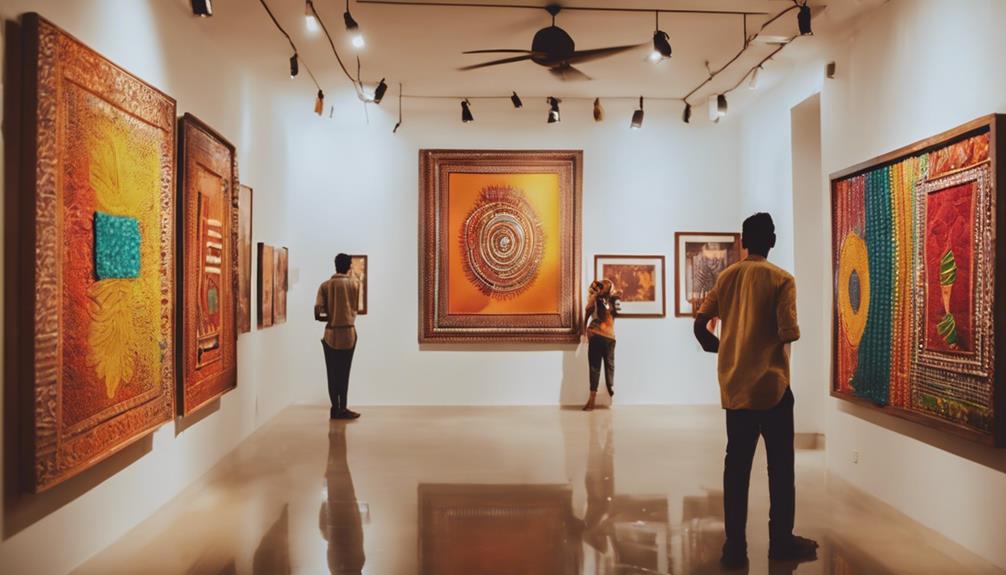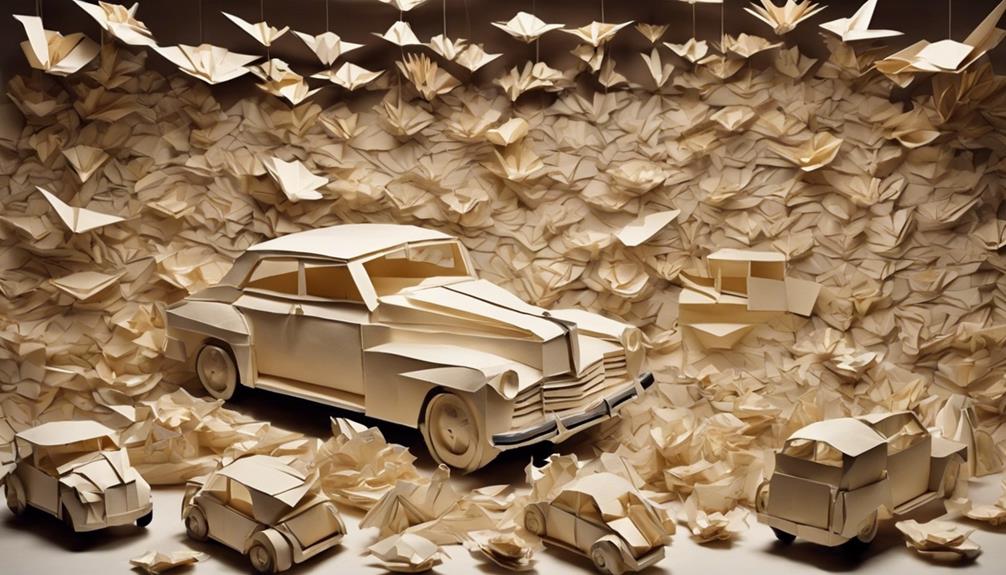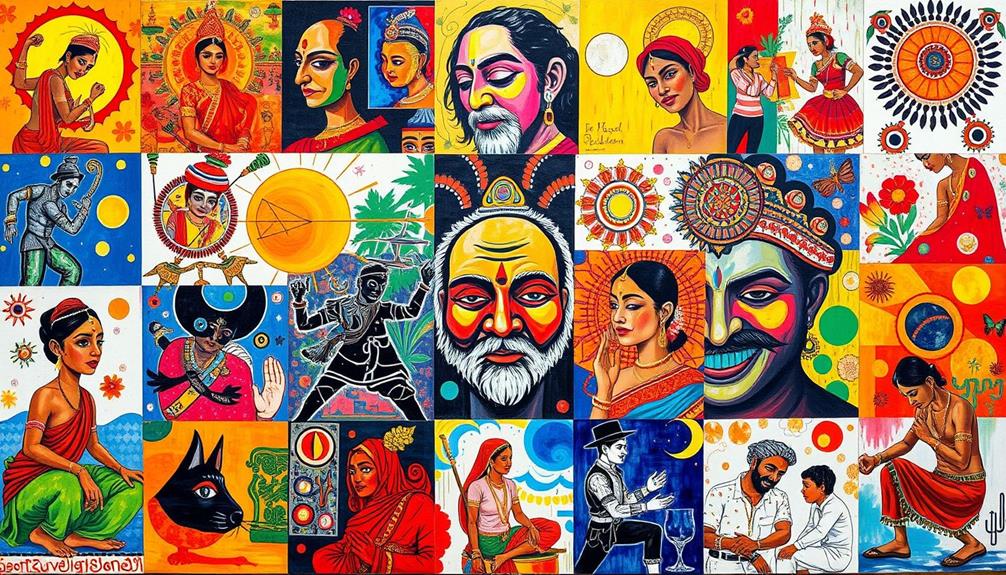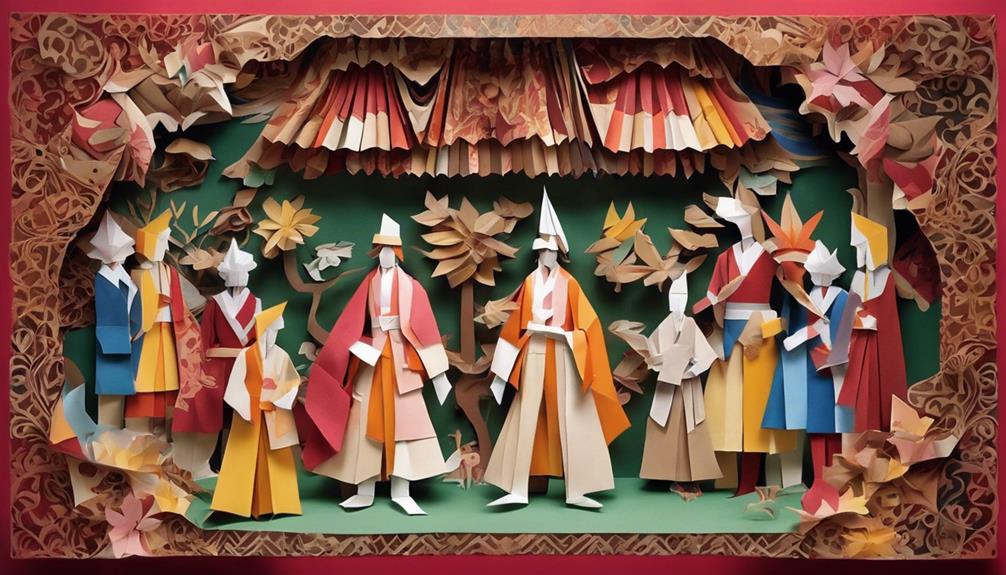Mumbai's cutting-edge art scene blends traditional roots with modern influences to create a vibrant hub of creativity and innovation. From diverse artistic styles in contemporary galleries to platforms nurturing emerging talents, the city offers a rich tapestry of artistic expressions. Innovative art installations like Yayoi Kusama's Clouds and Jitish Kallat's Here After Here After Here engage the community, exploring themes of time and memory. Artistic dialogues and workshops further enrich Mumbai's landscape, fostering collaboration and pushing boundaries. The fusion of tradition and modernity in Mumbai's art community reflects a dynamic evolution worth exploring for art enthusiasts.
Key Takeaways
- Mumbai's art scene showcases diverse styles and global influences.
- Emerging artists find nurturing platforms to express unique perspectives.
- Innovative art installations push boundaries of artistic expression.
- Modernism shapes Mumbai's art scene, blending Western principles with Indian heritage.
- Contemporary galleries like Project 88 and Tarq promote avant-garde art styles.
Artistic Diversity in Mumbai
Within Mumbai's vibrant art scene, artistic diversity thrives, showcasing a wide range of styles and influences. The city's galleries aren't only steeped in traditional Indian aesthetics but also play a pivotal role in promoting contemporary Indian art with global influences.
Emerging artists in Mumbai have found a nurturing environment within the art scene, allowing them to express their unique perspectives and contribute to the rich tapestry of artistic expressions present in the city.
Mumbai's art galleries serve as platforms for these emerging artists to exhibit their work, adding a fresh and innovative dimension to the already diverse art landscape. The fusion of traditional Indian art forms with global contemporary influences has attracted a broad spectrum of art enthusiasts, creating a dynamic and inclusive space for artistic dialogue and appreciation.
As a result, Mumbai's art scene continues to evolve, reflecting the city's progressive approach towards embracing diverse artistic expressions.
Emerging Talent Showcases

Emerging talent showcases in Mumbai serve as a launching pad for rising art stars, providing them with opportunities to exhibit their work in innovative exhibition spaces.
These platforms offer a fresh perspective on contemporary art, allowing young artists to experiment and challenge traditional boundaries within the vibrant art scene of Mumbai.
Through these showcases, new voices are amplified, contributing to the diversity and dynamism of the city's artistic landscape.
Rising Art Stars
Young artists in Mumbai, showcased in emerging talent exhibitions, are actively pushing boundaries and experimenting with new forms of expression. These emerging talents are embracing experimental forms and contemporary perspectives to carve out their unique artistic identities. By participating in these showcases, rising art stars are gaining recognition and establishing themselves in Mumbai's vibrant art scene.
Drawing inspiration from the city's rich cultural heritage, many artists blend traditional influences with modern sensibilities to create compelling and thought-provoking works of art.
Themes of identity, social issues, and environmental concerns are common threads woven into the narratives explored by these young artists. Their work reflects the diverse and complex realities of modern India, offering viewers a glimpse into the multifaceted nature of the country's cultural landscape.
Through their creative endeavors, Mumbai's rising art stars are contributing to the dynamic evolution of the city's art scene, fostering innovation and creativity among the next generation of artists.
Innovative Exhibition Spaces
In Mumbai's vibrant art scene, innovative exhibition spaces play a pivotal role in showcasing emerging talent and fostering creative dialogue. These spaces provide platforms for emerging artists to exhibit their work, engage with the local art community, and contribute to the city's diverse art landscape.
Some notable galleries in Mumbai that actively promote emerging talent include:
- Clark House Initiative: Known for showcasing experimental art forms and supporting young artists.
- Mumbai Art Room: Provides a platform for emerging artists to exhibit their work and engage with the local art community.
- Ministry of New: Highlights emerging talent through pop-up exhibitions and artist residencies, fostering creative dialogue.
- The Mumbai Assembly: Hosts exhibitions featuring emerging artists, contributing to the city's diverse art landscape.
- The Guild Art Gallery: Actively promotes emerging talent through curated exhibitions and artist collaborations.
Innovative Art Installations

Mumbai's cutting-edge art scene captivates audiences with innovative art installations that push the boundaries of traditional artistic expression. At venues like the National Museum of Contemporary Art in Mumbai (NMACC), installations such as Yayoi Kusama's Clouds and Jitish Kallat's Here After Here After Here engage the community through their cutting-edge and innovative designs.
Yayoi Kusama's Clouds, characterized by her signature polka dots and mirrors, offers immersive experiences that transcend individual perceptions. Similarly, Jitish Kallat's Here After Here After Here installation explores themes of time, memory, and history through a compelling visual narrative. These installations not only showcase the transformative power of art but also foster community engagement by sparking conversations and unifying people through diverse artistic expressions.
Visitors to NMACC are inspired by these innovative art installations, which integrate public art with architecture to create a unique and thought-provoking experience.
The Influence of Modernism

The influence of modernism on Mumbai's art scene has been profound, shaping the evolution of artistic expressions in significant ways. From the mid-20th century onwards, artists like Tyeb Mehta, M.F. Husain, and F.N. Souza introduced Western art principles into Mumbai's cultural landscape, blending them with Indian heritage.
This fusion of influences led to a redefinition of artistic norms, sparking a shift towards individualistic narratives, experimentation with form, and a celebration of bold expression.
Modernism's Impact on Art
Modernism's profound influence on art history is unmistakable, heralding a departure from traditional artistic norms towards innovative and experimental expressions. This shift has had a lasting impact on contemporary artists, particularly in the modern Indian art scene.
Some notable effects of modernism on art include:
- Breaking Traditional Conventions: Modernism challenged established artistic norms, encouraging artists to explore new forms of expression.
- Emphasis on Individuality: Modernist movements like Cubism and Surrealism emphasized individual expression and psychological exploration, paving the way for artists to investigate their unique perspectives.
- Innovation and Experimentation: Modernist artists like Picasso and Kandinsky revolutionized art by embracing abstract and non-representational styles, pushing the boundaries of what art could be.
- Shaping 20th-Century Art: Modernism's influence led to a diverse range of art movements, such as Abstract Expressionism, which continue to shape the trajectory of contemporary art practices today.
Evolving Artistic Expressions
Amidst the vibrant art scene in Mumbai, artists continue to explore urban complexities through a modernist lens. The contemporary art scene in Mumbai is a melting pot of creativity where modernism plays a pivotal role in shaping artistic expressions.
Galleries such as Jhaveri Contemporary and Nature Morte are at the forefront, showcasing artists like Yamini Nayar and exhibitions like 'Parallel Cities II' that investigate urban complexities through a modernist lens. Artists like Neha Choksi at Project 88 challenge traditional norms by blurring boundaries between engineering and geological processes, embodying a modernist approach to art.
The 'Gandi Baat' Exhibition at 47-A reflects modernist influences by emphasizing design activism and political discourse to engage audiences through art. Additionally, Krishna Reddy's Exhibition at Experimenter highlights innovative printing techniques and craftsmanship, embodying a modernist spirit that continues to drive artistic expressions in Mumbai's dynamic art scene.
Artistic Dialogues and Workshops

- Artistic dialogues foster in-depth conversations among diverse art stakeholders.
- Workshops provide practical learning opportunities in different artistic mediums.
- Renowned artists offer valuable mentorship to emerging talents in Mumbai.
- These platforms encourage artistic experimentation and collaboration, enriching the city's cultural landscape.
Contemporary Art Galleries Overview

Mumbai's contemporary art scene thrives with over 20 cutting-edge galleries in South Mumbai alone, showcasing a wide spectrum of artistic styles from traditional to avant-garde.
These galleries, such as Project 88, Tarq, and Volte, play a pivotal role in promoting contemporary art and providing a platform for South Asian artists to exhibit their work.
Galleries like Chatterjee & Lal in Colaba are known for their unique blend of tradition and modernity, fostering an environment where artists can experiment and showcase innovative artworks.
Akara Art gallery stands out for celebrating diversity in art, offering emerging artists a space to express their creative visions and engage with the art community.
The vibrant contemporary art scene in Mumbai is constantly evolving, with renowned galleries like Sakshi Gallery and Jehangir Art Gallery leading the way in showcasing modern and contemporary Indian art on a global platform, contributing significantly to the appreciation of art in the region.
Mumbai's Artistic Heritage

The artistic heritage of Mumbai is deeply intertwined with its diverse cultural history, blending traditional Indian art forms with contemporary influences. In exploring Mumbai's art scene, one can witness the rich tapestry of artistic expressions that reflect the city's cultural heritage.
Here are four key aspects that highlight Mumbai's artistic heritage:
- Local Artists: Mumbai has been a breeding ground for talented local artists who've contributed greatly to the city's art scene, infusing their work with cultural nuances and personal experiences.
- Cultural Heritage: The city's art scene draws inspiration from India's rich cultural heritage, incorporating elements from various traditions and art forms to create a diverse range of artistic expressions.
- Historic Art Galleries: Established art galleries like Chemould, founded in 1963, have been instrumental in nurturing local artists and shaping the trajectory of Indian modern art, preserving the city's artistic legacy.
- International Recognition: Mumbai's vibrant art scene has gained global recognition through platforms like art biennales and galleries, showcasing the city's diverse artistic talent on an international stage.
Fusion of Tradition and Modernity

Artists in Mumbai skillfully blend traditional Indian art forms with modern and contemporary styles, creating a charming fusion of tradition and modernity in the city's vibrant art scene. Indian artists, both established and emerging, draw inspiration from Mumbai's rich cultural heritage, infusing innovative techniques and concepts to reflect the dynamic urban landscape.
This fusion is evident in galleries across the city, where artworks seamlessly integrate traditional craftsmanship with cutting-edge technology. The art spaces actively promote the harmonious coexistence of heritage and innovation by showcasing pieces that bridge the gap between classical art forms and contemporary expressions.
Moreover, the artistic community in Mumbai embraces the ethos of honoring tradition while embracing modernity, resulting in a diverse and vibrant art scene that celebrates the evolution of artistic practices. The infusion of digital art into traditional forms further exemplifies Mumbai's commitment to blending the old with the new, creating a unique artistic identity that captivates both locals and visitors alike.
Frequently Asked Questions
What Is the East Village Art Scene?
The East Village art scene was a vibrant cultural movement that emerged in the 1950s in New York City. Known for its avant-garde and experimental art, it provided a haven for artists seeking affordable living spaces and creative freedom.
Prominent figures like Jean-Michel Basquiat, Keith Haring, and Andy Warhol shaped this scene, characterized by underground galleries, performance spaces, and street art. Its influence extended to pop art, street art, and graffiti culture, leaving a lasting impact on contemporary art.
What Is Cutting Edge Art?
Cutting-edge art encompasses innovative, boundary-pushing artistic practices that challenge traditional norms. It involves new technologies, unconventional materials, and experimental techniques to create thought-provoking works.
This art aims to provoke dialogue, spark creativity, and push boundaries. Artists explore social issues, political themes, and personal narratives uniquely.
Dynamic and ever-evolving, cutting-edge art is at the forefront of contemporary artistic expression, continuously redefining what's considered art.
Conclusion
As the vibrant canvas of Mumbai's art scene continues to evolve, it serves as a reflection of the city's dynamic spirit and cultural richness.
Like a tapestry woven with threads of tradition and modernity, the art community in Mumbai showcases a diverse range of talent and creativity.
From innovative installations to traditional art forms, Mumbai's artistic landscape is a testament to the city's enduring legacy as a hub of creativity and expression.









